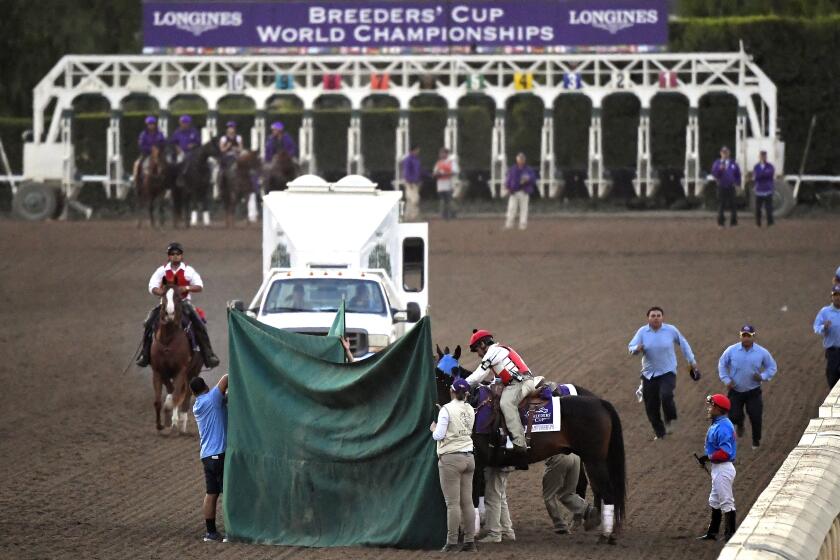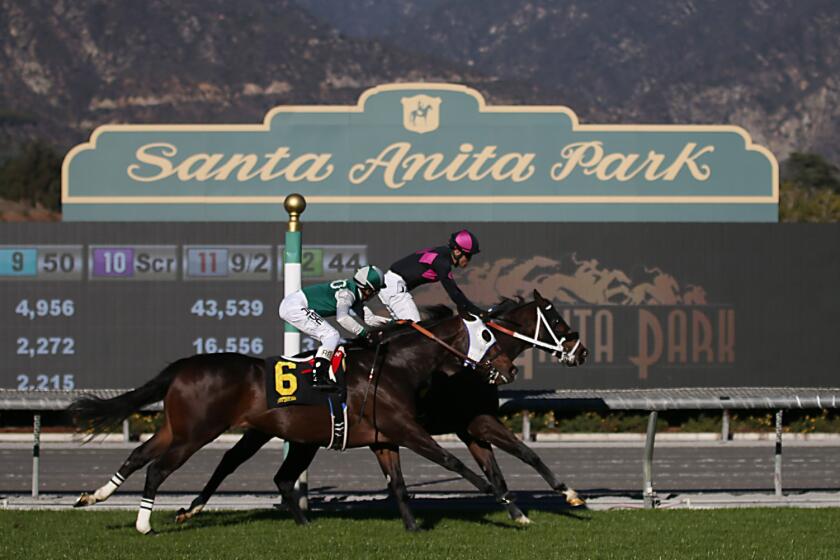Why a trainer with 527 violations is still racing horses at Santa Anita

- Share via
Santa Anita Park has made a point of trying to be a leader when it comes to horse safety, often proactive in its enforcement of rules, even before official adjudication.
But now, it is raising some eyebrows in not taking any action against trainer Dan Blacker, who has been cited for 527 violations by the California Horse Racing Board. The violations are all the same, not scheduling a veterinary exam 72 hours or less before a workout, a timed high-speed training run.
The reasons the trainer, the track and the regulator find themselves in this spot of muddled action underscores how the sport sometimes can be weighed down by its own doing.
The alleged transgressions were detected after Animae, an unraced 2-year-old filly, broke down in training and was euthanized because of injuries to her pelvis and vertebrae July 1. Animae, a $250,000 purchase, had just completed a three-furlong workout over the dirt training track.
The Stronach Group announced it will pay for relocation costs for horses and trainers and install a synthetic surface on the training track at Santa Anita.
As is mandatory after every fatality, the CHRB conducted a necropsy and investigation into the death. Investigator Steven Manila found that there was no pre-veterinary exam listed in three of her four workouts, including the fatal one. He then audited the trainer’s workouts from Jan. 1, 2022, through July 1, 2023, and found that of 789 official workouts, 527 were conducted without a veterinary exam.
Dr. Jeff Blea, equine medical director of the CHRB, said there was nothing unusual in the necropsy and that it was impossible to know whether a veterinary check could have prevented the breakdown.
Last year, Santa Anita did not allow trainer Richard Baltas to enter horses into races after an employee of his was caught on video giving an oral supplement into the mouths of 23 horses by syringe. It is illegal to administer any kind of medication to a horse within 24 hours of racing.
The Stronach Group, through its racing division called 1/ST Racing, did not wait for the CHRB and banned Baltas from all its tracks six weeks before the complaint was issued. The CHRB later suspended Baltas’ license until early December of this year. After Santa Anita took its action against Baltas, some owners transferred their horses to Blacker.
The size of a race horse and its natural instincts make it nearly impossible to survive serious injuries at the track, but many are trying to improve the odds.
The decision to ban Baltas and not ban Blacker did not rest upon Aidan Butler, chief executive of 1/ST Racing, but with Dr. Dionne Benson, chief veterinary officer of Stronach Group, who reports directly to Belinda Stronach, chief executive of Stronach Group, instead of the board.
“The big difference is we had the evidence with Baltas [because our employee found it],” Benson said. “Here we’re looking at just the complaint. … I can’t get in the middle of a CHRB investigation. The difference is having a smoking gun or relying on a complaint.
“[Blacker] has had one fatality and one injury since 2019. He’s not a person that is a red flag.”
Blacker had a fatality in 2012 (That’s Dangerous) and one in 2013 (Rosies Rascal), both while racing.
The trainer issued a statement Saturday that said in part:
“I learned that our long-established procedures, while complying with Santa Anita workout rules, were not always in line with the [CHRB] rule regarding pre-work inspection and reporting. As soon as I was made aware, we immediately began to operate in compliance with the rule.
“I take full responsibility for this matter and the consequences it will bring forth.”
Given the number of courses and amount of information that trainers are given, Blea said he didn’t see a situation in which any trainer could be caught unaware of this rule.
Even after 50 years, Secretariat is the standard against which all horses are measured. His Kentucky Derby, Preakness and Belmont records still stand.
“Plus, there is a rule in the rules that says the licensee should know the rules,” Blea said.
There also has been a groundswell of animus at Santa Anita calling this a case of unequal treatment.
Butler and Blacker, both from Britain, are good friends, and other trainers believe their relationship brings benefits.
When Santa Anita was trying to clean up its image after a surge in fatalities in 2019, it invited the media to the track for an explanation of reforms by Benson, to hear comments from Butler and then a visit to Blacker’s barn for a show about how well the animals are treated.
Blacker has helped Santa Anita with media opportunities, and Butler has called on him to endorse a new protocol in trainer meetings. His wife is Christina Blacker, a host and analyst for horse racing coverage at FanDuel TV.
Aidan Butler, Santa Anita’s new racing boss, met with the Los Angeles Times to talk about the challenges ahead after 31 horse deaths at the facility.
“I think the feeling among many trainers, whether real or assumed, is that Aidan has a small posse of people, mostly English, that he hangs around with and it brings benefits,” said one prominent trainer who did not want to be identified because of the sensitivity of the situation.
“It may only go as far as if Dan needs a lightbulb changed [at his barn], he calls Aidan. This is all based on what nobody knows, but they see them all hanging out at country clubs and being invited to social gatherings and it gets them thinking. It is certainly what they feel, but that doesn’t make it a crime.”
The backstretch at a racetrack can be filled with almost as many rumors and gossip as there are losing tickets.
“Trainers are conspiratorial by nature, especially if they think someone is getting favored treatment,” the trainer said.
Butler bristles at the assertion he plays favorites.
“Having lived on race courses for years, I’m friends with lots and lots of horsemen and women, obviously this person isn’t one of them,” said Butler when told what the trainer said. “I don’t think there should ever be a question about my integrity. Actually, being a friend of mine works the other way: You are less likely to get a break from me because you are a friend. I’m always aboveboard.”
Butler added that he doesn’t get involved in the changing of lightbulbs.
Despite being in the same business, there is little coordination between the operator and the regulator. The track was not made aware of the CHRB investigation until it was posted on the CHRB website Tuesday, some 32 days after the complaint was issued.
Butler said he learned about it Wednesday and that Blacker did not tell him about it in advance.
A system that would allow someone to rack up 527 violations without being caught also points to something that is broken. Has the CHRB created a rule that has no infrastructure to enforce it in real time?
“[Thursday] there were 551 horses that were cleared for workouts,” Blea said. “It’s just a matter of not having the resources to monitor all of this. There were more than 400 this last weekend at Santa Anita.”
Blea said they handle enforcement the best they can.
“There is somewhat of an honor system that the trainers know the rules and follow them,” he said. “Then if there is an injury or fatality, our investigators will look to see if there are any other rules violations. In addition, workouts are audited on a random basis, based on intelligence or workout patterns that look odd or suspicious.”
The randomness only occurs in workouts because Santa Anita and Del Mar pay a private contractor to make sure that everyone is in compliance before they run.
Benson said the track would be willing to take on the job of checking to make sure pre-workout inspections are done, but it doesn’t have access to the system where “Vet Confidentials” are stored. The word “confidential” is key as the CHRB, by statute, is not allowed to share information outside the regulatory body.
It’s unclear what kind of penalty the CHRB stewards will give Blacker if it’s found he committed the infractions. Generally, it would be between $100 and $1,000 based on the number of infractions. But, 527 is a number no one has ever dealt with before.
More to Read
Go beyond the scoreboard
Get the latest on L.A.'s teams in the daily Sports Report newsletter.
You may occasionally receive promotional content from the Los Angeles Times.















